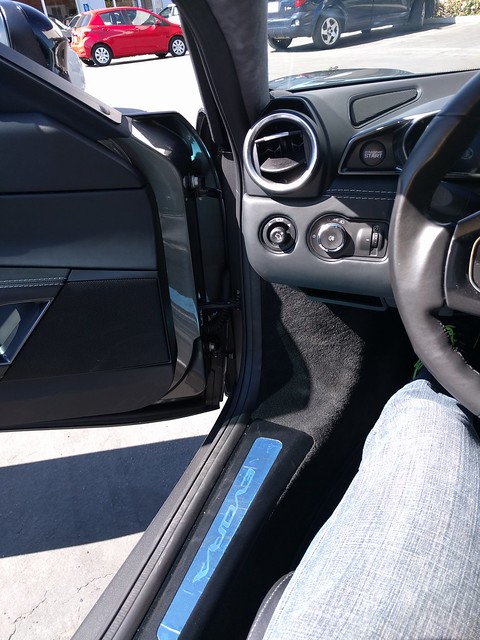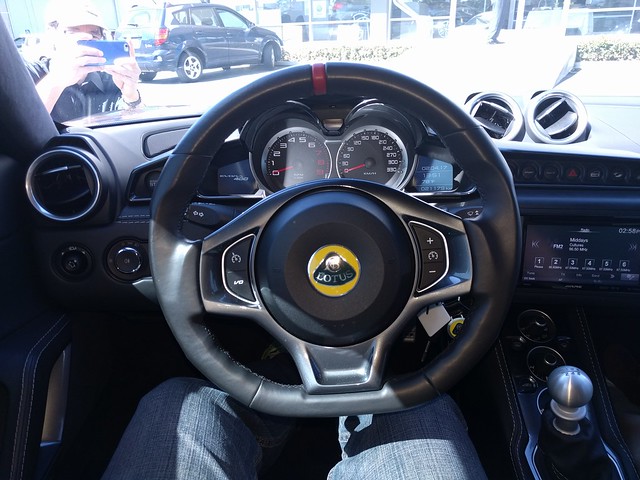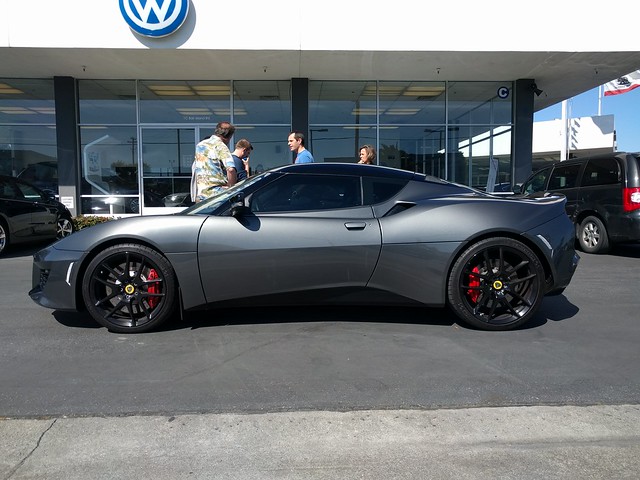Early Emira reviews are in – we have a winner
Jay Leno reviews the Evora 400
Russell Carr stops by Jay Leno’s Garage with a couple of Lotus Evora 400s
Lotus Evora 400 first drive
Last week Tom Sutton from Boardwalk Lotus invited the GGLC to swing by and take a look at the new Evora 400 which will be begining US deliveries later this summer. This particular car was one of two euro-spec demo cars that have been going all over the US to attend the auto show circuit and had 21000 kms on it. I got the chance to drive it for a few miles and wanted to write up my thoughts on the car. These are all my personal opinions and will be coloured by my experiences from owning an Elise for 10 years and an Evora S IPS for ~8 months.
Exterior

When the Evora 400 was first announced I have to say that I was not a big fan of the looks. The sharp lines on the new front and rear looked a little “boy racer” to me and pushed me into getting an Evora S instead of waiting for the 400. However seeing the car in the flesh I have to say that the new front end looks much better in person and works really well in this carbon grey colour. The black line above the splitter kind of merges into the body and removes the thing I found most annoying about the front. The plastic grill replacing the mesh looks quite good as well.

The rear also looks much better in person and I’d have to say that the Evora 400 looks very modern and contemporary.
Ingress/Egress

This is perhaps the single greatest improvement of the 400 over the first gen Evora. The side sills are a lot lower and narrower than those of the Evora S (below) which means it is as easy to get in and out of as a regular sports car – no lotus position needed. Additionally the speaker enclosure in the door has been made smaller and thinner which means your feet don’t hit the door every time you get out (even with size 14 shoes). This has been my biggest annoyance with the Evora as a daily driver as you have be even more careful with your feet getting out that you have to in the Elise.

Interior
The first thing you notice about the interior is the extra legroom in the drivers seat. The narrow sill appears to have continued towards the wheel well to give your left leg more room. The manual cars now finally have a dead pedal where you can rest your foot and if feels like there is more footroom in general which came in handy for my size 14 feet. That said my Evora S is an IPS so its hard for me to compare against the manual 400. It also felt like my right knee had some more room though the console didnt appear to be much narrower.

The next thing you notice is the easy access and visibility of all the switchgear. You no longer have to cock your head and look behind the steering to squint at the controls. Plus they are now black with white lettering which makes them significantly easier to read than the old chrome buttons. The digital parts of the dash are now white on black and people who have been driving the car for extended periods tell me that they are easier to read that the red displays on gen 1. The steering wheel material has changed and feels more “rubbery” than my S – this is one change I would love to make to my car if possible. The side mirror controls have been moved to the dash for easy access while the trunk and fuel buttons have been moved to the door. Extra points for the trunk button no longer requiring the impossible combination of key in ignition, car in park, ebrake on, full moon night, fifth wednesday of the month, etc… to work 🙂

The other thing I really liked was the HVAC controls are easier to turn and have many more detents instead of the current half dozen or so. The stereo is also different but I did not get a chance to play around with it. The glove box is now manual instead of electric which aligns with simplify and add lightness.

The seats have switched from Recaro to Sparco and now have side airbag included. The stitching is a little different but they are just as comfortable as the original car. They now have a little leather pull to flip the seats forward which is much easier to reach and IMHO looks a lot cooler. The rear seats are as vestigial as ever.

Driving impressions
I only got to drive the car for a few miles in traffic but the ride and handling felt the same as the S. It felt fast but with the lmited opportunities to accelerate it did not feel that much faster than my S. The thing I really liked about the drive was the exhaust which is sportier (louder with better tone) and has a button that controls the noise level independent of the ECU mode. This means you can drive the car in sport mode with the quiet exhaust or be in regular mode with the loud exhaust – the S ties the louder exhaust to the sport mode only which can get a little annoying in city driving. The shifter is also really smooth and felt a better than the other Evoras I have driven and miles ahead of the Elise.
The other thing I liked is that the Evora 400 is better built than the Elise and does not have all the rattles and squeaks you have come to expect from a Lotus. The demo car had over 13k miles on it and felt like a quality item just like my S does after 2 years and ~15k miles.
Final Thoughts
My biggest takeaway about the Evora 400 is that it is a much more useable car than the S. It retains the excellent driving dynamics of the original car and adds a nice boost in power while making it easier to live with on a day to day basis. People considering a Porsche 911 as a daily driver should really have a look at the Evora 400 – it is now a competitor in terms of usability as well as performance. For me personally while it is a lot more car I can’t justify the premium over my existing S. That said the upcoming 400 convertible might make me change my mind 😉
Lotus Elise Suspension comparo: Base Vs Nitron 46mm SA Vs Penske SA
One of the great things about being a car guy in CA is that there is a large number of fellow addicts around. This means that if you ever want to put some high dollar upgrades on a car you can usually find someone with a similar setup and get some first hand info about it. The latest to take advantage of this was Vincent from the GGLC who has been thinking of getting a set of single adjustable coilovers for his Elise and was having a tough time deciding between the Nitron 46mm Race Pro 1-Way and the BWR Penske Single Adjustable. Since the shocks run $2500+ he sent out some feelers on the forums and was able to get 3 cars together to try some back to back to back driving on some interesting roads for a highly subjective and completely unscientific comparison.
Mag Blue (Vincent)
2005 Elise
Base suspension
LSS wheels
R888 tires
Black (Scott)
2008 Exige S 240
Nitron 46mm Race Pro 1-Way (450/600 “soft” springs)
Exige Wheels
R888 tires
A-arms for extra camber
Titanium (Rahul)
2006 Elise
BWR Penske SA (500/700 “street/track” springs)
Rota wheels (15/16)
RA1 tires wider than stock (205/50R15 245/45R16)
Aligned, lowered and corner balanced to BWR spec
Route
The road we used for the test was CA-35 from CA-92 upto Alices Restaurant which is an extremely bumpy road with lots of cracks and undulations. It is however quite a twisty road so is very popular with sports cars, bikers and cyclists. We also did drive La Honda road from Alices down to CA-1 but that section of road is so smooth that we could barely tell the difference and ended up using the original stretch again.
This was far from a scientific test and is basically about subjective feel of the various suspensions on a fairly bumpy road. We did not have any specific test criteria going into this and just wanted to drive all 3 cars. I am just going to describe my feedback from all 3 in the order I drove them:
Nitron 46mm Race Pro 1-Way (450/600)
The first car I drove was Scotts Exige S240 on the Nitrons. The car was set to 15 FFH front and rear which is a little softer than the recommended Nitron settings. The two things I noticed were that the steering was a lot lighter (extra camber A-arms) and that ride did feel pretty harsh on the on the bumpy sections. I had plenty of confidence in the car but I was feeling a lot of bumps and vibration through both the seat and the wheel. That said it certainly was not undrivable – just harsher than I would want on an everyday drive.
Lotus Base Suspension
I thought the Nitrons were harsh but when I drove the base car over the same section of road I realised just how much worse the base car is. It was crashing and skipping over the bumps and got lots of unpleasant feedback through the wheel. I should add that this is in relation to the Nitron/Penskes only – the base suspension Elise is still an incredibly capable car and I drove mine for 90k miles on that suspension including dozens of trips down CA-35. Driving the base car is still a great experience and only felt bad because it was sandwiched between two more capable (and more expensive) setups.
BWR Penske Single Adjustable
After driving the other cars I took my car for a spin down the same road just to see how it handled those bumps. While I have ~800 miles on these shocks most of them were at COTA and I had not driven a truly bumpy road on them before. The car started the day in my “highway” settings of FS/FS-5 which are significantly softer than BWR suggested settings for the street. These settings disconnect you from road harshness and expansion joints but can hit the stops on big bumps which is no fun. After Vincent drive in my car he said it felt too soft so I moved it up to FS+10/FS+25 for Scott before following him on the second run. I did notice that the rear appeared to be “bouncing” a lot over the bumps which is something he reported as well at the next stop. I started out the first couple of miles on the same settings and quickly realised that while there was no high frequency harshness the car was just too bouncy and underdamped over the bumps. I pulled over and bumped it to FS+15/FS+35 which gave it a much more compliant ride with minimal harshness (less than the Nitrons).
Final results
In the end I have to say that the Nitrons and the Penskes are both a significant improvement over stock in terms of comfort and drivability. From this informal test I’d have to say that the Penskes can be adjusted to a softer setup (this might also be due to the extra tirewall from the 15/16 wheels) but some folks can find that to be too “Cadillac-y” and unconnected. The Nitrons were very good on the smoother sections but cannot be made as “soft” as the Penskes. That said we dont know if the softer adjustments cause the Penskes to lose a bit on track (not AutoX). I have driven 3 days at COTA with Penskes but that is possibly the smoothest track in the US plus without a back-to-back its hard to really judge.
In the end if you want a good aftermarket suspension you cant really go wrong with either of these options and both vendors will work further with you to come up with the right package for your specific needs. They are both a massive upgrade over stock in terms of drivability and I wish I had bought them years ago instead of waiting 90k miles to make the change.
Update: Added a note that the ride comfort of the Penskes is affected by the extra tire wall from the smaller wheels.
2011 Lotus Elise Video
While we have shown you the new 2011 Elise and its fuel economy before, EVO just posted this video of their road test of the new 1.6L Elise variant for the UK. Enjoy!
Evora on Ice
Winding Road magazine has driven the Lotus Evora on the Circuit de Serre Chevalier ice-racing circuit and came away impressed with the poise and handling
There’s a perfect feeling when you set up a curve just right, because it’s a delicate balance that you learn only after lots of tries. When we started hitting it curve after curve in the Evora with the spikey Sottozeros, we were in heaven. The 276-horsepower, 258-pound-foot Toyota 3.5-liter V-6, combined with all of the Lotus magic at the chassis and very responsive throttle setup, really did make us damned near invincible.
Click through to read the full article.
Autocar crown Evora “Britain’s Best Driver’s Car 2009”
The Lotus Evora shows its pedigree fending off tough competition from the world’s best driver’s cars to become Autocar favourite.
The competition included rigorous road and track assessment, using the stunning roads around the South Downs and the fantastic high speed corners at the Goodwood race circuit. The feature included driver’s cars from Aston Martin, Nissan, Porsche, Audi, Lamborghini and Jaguar.
Chas Hallet, Autocar Editor said about the Evora, “The best here. Brilliant on the track. Nimble, delicate and forgiving. Even better on the road.”
Autocar magazine in summing up the competition added, “Decisions don’t come much more clear cut than this, with nine out of 10 judges placing the Evora first. This contest is about finding a car that is not only technically capable, but also thrilling and engaging wherever you drive it, and the Lotus nails those criteria”.
The unique mid-engined 2+2 Lotus Evora combines a super stiff extruded and bonded Aluminium chassis with decades of vehicle dynamics knowledge employed to tune its race car derived double wishbone suspension. The result is a great driver’s car that offers exceptionally high levels of ultimate grip, with performance and braking to match.
Roger Becker, Vehicle Engineering Director said, “The dynamic ability and driving experience of the Evora were the foundation of the engineering process and we are delighted that Autocar has recognised this by giving the Evora this accolade. The Evora offers the great Lotus driving experience in a very comfortable, practical, refined and efficient package, and with only 205 g/km of CO2 it shows that the Evora is a supercar for the 21st century.”
Luke Bennett, Director of Lotus Cars commented, “We are really pleased to win this title as it not only demonstrates the engineering expertise and brilliant manufacturing at Lotus, but also asserts our position in this very exclusive and competitive sector. There is huge global demand for the Evora and to cope with this high demand we are taking on over 150 manufacturing staff, which is roughly a 30% increase.”
Click here to watch Steve Sutcliffe talk about the Evora driving experience. The full article is on the Autocar website.
Top Gear Evora Review
Jeremy Clarkson reviews the Evora on the new season of Top Gear






